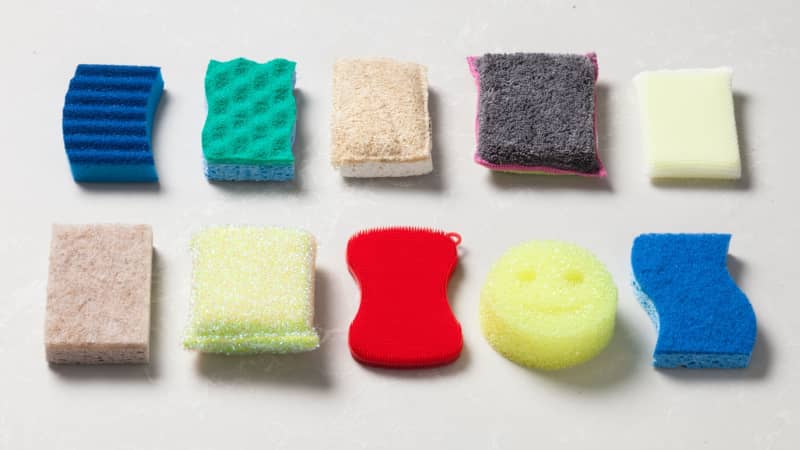Liquid Dish Soap
Equipment Review
Doing dishes is a dirty job. Is there a kitchen sponge that makes it easier?
Published May 28, 2019. Appears in America's Test Kitchen TV Season 20: Childhood Favorites, Grown Up

We were in the test kitchen, making scrambled eggs without oil or butter in stainless-steel skillets over high heat. The eggs stuck to the pans and made terrible messes. The test cooks working around us kept shaking their heads, no doubt wondering why we hadn't switched to nonstick pans or tossed pats of butter into the skillets. We just smiled and ignored them.
We wanted those eggs to stick to the pans. We'd just started working on a review of kitchen sponges and needed to use them for some challenging cleaning tasks. As anyone who's ever goofed up their scrambled eggs knows, getting these skillets clean would be tough.
Several major brands had multiple options for all-purpose sponges, so we conducted a two-step preliminary test: cleaning onions and sticky, cooked-on barbecue sauce off skillets and washing delicate wine glasses. We eliminated the lowest performer from each brand. Our final 10 sponges varied considerably in price, from about $0.70 to about $6.00 per sponge, and came in a wide variety of designs and materials.
We expect a lot from a kitchen sponge and tested accordingly, using them to clean nonstick, traditional, and cast-iron skillets containing a variety of cooked-on foods; mixing bowls with sticky biscuit dough; stained carving boards; cheese-smeared box graters; dirty chef's knives; fragile wine glasses; and small measuring spoons. Throughout testing, we controlled both the water temperature and the amount of soap used. Finally, we purchased three additional copies of each sponge and sent them home with staffers for several weeks of use in their kitchens.
Some sponges were ineffective and sometimes downright unpleasant to use. But many performed well, and several really impressed us. Our favorites were more versatile, stayed cleaner longer, and made quicker work of tough messes, such as those pesky stuck-on scrambled eggs.
When we think of a kitchen sponge, most of us picture a blue or yellow rectangle with slightly rough, textured material on one side. We had a sponge like that in our lineup, as well as a few others that were a similar size and shape, but many of the sponges were very different. We grouped them into three main styles.
First, there were those familiar sponges made of fairly soft, flexible material with an abrasive pad on one side. The gentle parts of these sponges were made from either foam or cellulose. The second category consisted of sponges with soft foam cores encased in semiabrasive fabrics. We also had two outliers. One sponge was made entirely of silicone and covered with tiny bristles on two sides. The other was made of a speci...

The mission of America’s Test Kitchen Reviews is to find the best equipment and ingredients for the home cook through rigorous, hands-on testing. We stand behind our winners so much that we even put our seal of approval on them.

Kate is a deputy editor for ATK Reviews. She's a culinary school graduate and former line cook and cheesemonger.

This is a members' feature.